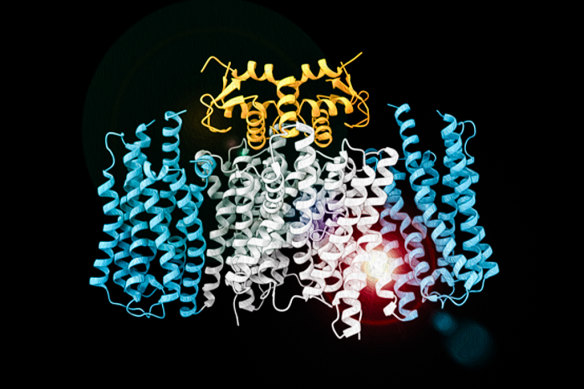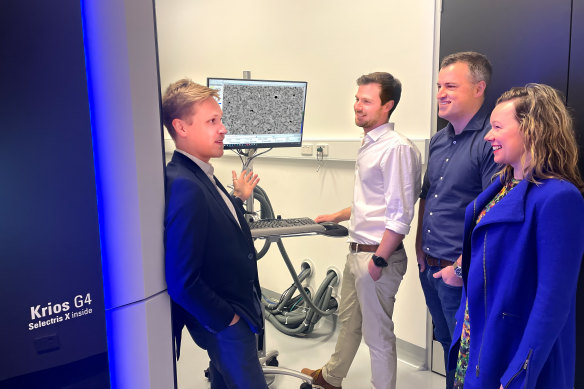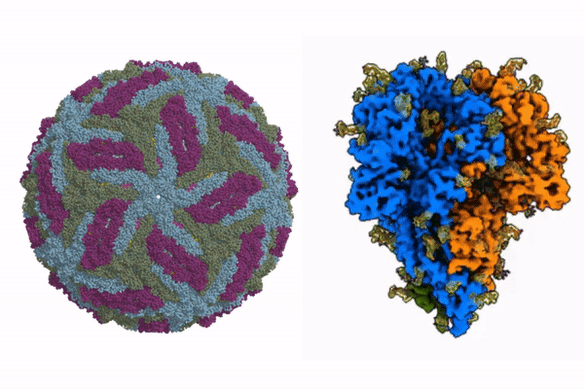By Angus Dalton
Australian scientists have made the world-first discovery of a plant-like protein in human cells, which could become a powerful drug target for controlling tumour growth and treating cancer.
Researchers at Monash University used a cryo-electron microscope to determine the structure of LYCHOS, a cell regulator ubiquitous in the body but only discovered in 2022.

A structural image of LYCHOS, a plant-like protein discovered in humans by Australian scientists.Credit: Ellisdon & Halls et al, Nature
One part of the structure contained a well-known type of cellular membrane protein. But the other part was unfamiliar; the scientists couldn’t find similar proteins in humans or animals.
Then came the surprise: they realised the structure was almost identical to a plant protein that transports auxin, a hormone that helps bend stems and leaves towards sunlight to boost photosynthesis.
“It was really this link between plants and humans that wasn’t known before,” co-lead author Associate Professor Andrew Ellisdon said. “We didn’t actually think that humans had any auxin-like transporters in them, but this was the major discovery.”
There are several key aspects to LYCHOS that make it a promising drug target, according to the researchers, who published their work in Nature.

Study co-authors (from left) Dr Charles Bayly-Jones, Dr Chris Lupton, Associate Professor Andrew Ellisdon and Associate Professor Michelle Halls in the cryo-EM lab.Credit: Monash University
In humans, the protein triggers cell growth when there’s plentiful cholesterol and blocks growth when there’s not enough, said co-lead author Associate Professor Michelle Halls.
“Cancer cells can accumulate way more cholesterol than normal cells to allow unrestricted cell growth,” Halls said. “This is why blocking LYCHOS would be a good treatment strategy for cancers.”
The fact the protein is so plant-like and unusual offers an extra advantage, Ellisdon said.
“Because there are no other proteins very similar to LYCHOS in humans, that makes it a really nice drug target. If there are lots of similar proteins in the body, it can be difficult to target them specifically, and you get off-target effects with drugs.”

Leaps forward in cryogenic electron microscopy have led to high-resolution imaging of micropscopic structures, such as Zika virus (left) and the COVID-19 spike (right).Credit: Wikimedia/K. Zhang et al., Quarterly Reviews of Biophysics Discovery, 2020
Decades of research has already gone into auxin transporters in plants, giving scientists a head start on inhibiting the LYCHOS protein in humans.
“We want to understand its role in some of the diseases where cell growth goes wrong,” Ellisdon said. “I think we will be able to inhibit this protein which will hopefully slow down growth.”
The other part of LYCHOS is made up of a G protein-coupled receptor (GPCR), a well-understood structure that’s a common drug target because it exists on cell membranes, so it’s easy to reach with medicine.
“A lot of the really well-known therapeutics like beta blockers for cardiovascular disease, salbutamol for asthma, they’re all targeting G protein-coupled receptors,” Halls said.
The scientists and their colleagues used cutting-edge cryo-electron microscopy to snapshot millions of low-resolution images of LYCHOS, which they combined into a high-resolution, 3D model.
The microscopy process saw lab-grown samples of the protein taken to temperatures lower than minus 160 degrees, which stops atoms vibrating and protects the sample from getting scorched by the microscope’s electron beam.
“Cryo-EM is really revolutionising our ability to capture protein structures and then target those therapeutically,” Ellisdon said.
The Examine newsletter explains and analyses science with a rigorous focus on the evidence. Sign up to get it each week.